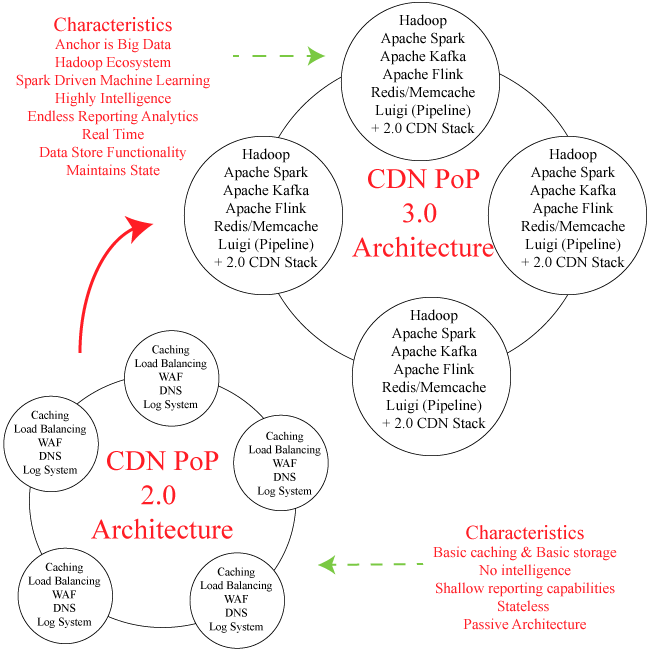Two generations of CDN PoP architecture have come and gone. The CDN PoP architecture is the software stack that powers the content delivery services. The 1.0 architecture was developed almost two decades ago, which was a great fit for websites of that day – small objects being delivered over slow internet connections. The 2.0 architecture is in use today and by year end – it will cease to exist. The 2.0 is comprised of the basic software stack, very little intelligence capabilities and no deep analytical functionality. Its architecture is passive, reactive and stateless. The goal of 2.0 architecture was to cache content at the edge, do some simple processing at the edge, and manipulate the middle-mile to get the extra ounce of performance out of TCP. The 2.0 architecture is anchored by the caching software, surrounded by services such as load balancing, log processing, DNS, and so on. The 3.0 architecture is dramatically different.
The 3.0 PoP is intelligent, anchored by big data and machine learning functionality. It is the future of edge delivery, and magnitudes of order more advanced than 2.0. At a minimum, each PoP will be anchored by a Hadoop ecosystem, comprising of HDFS, Apache Spark, Apache Flink, Kafka, Redis, and many other open source plugins that have been created by the likes of Facebook, Google, LinkedIn, Spotify, and so on. In fact, the 3.0 PoP is already in use in places like Facebook, LinkedIn and Twitter. The LinkedIn’s of the world are ahead of the CDN pack when it comes to the development of innovative web services that are injecting mind-boggling intelligence into the content delivery infrastructure. What does this mean to companies like Level 3 and Akamai? For Level 3, it isn’t good news. For Akamai, it’s great chance to transform its business model. In fact, we’ll answer that question in a research post. The takeaway, the future of the CDN PoP is in the Hadoop ecosystem.
| 2.0 PoP Characteristics |
3.0 PoP Characteristics |
| Anchor is Caching Platform | Anchor is Big Data |
| Basic Storage | Hadoop Ecosystem |
| No ML Capabilities | Spark Driven Machine Learning |
| No intelligence | Highly Intelligence |
| Shallow reporting capabilities | Endless Reporting Analytics |
| Batch Oriented | Real Time |
| No Data Capabilities | Data Store Functionality |
| Stateless | Maintains State |
CDN PoP 3.0 Architecture
